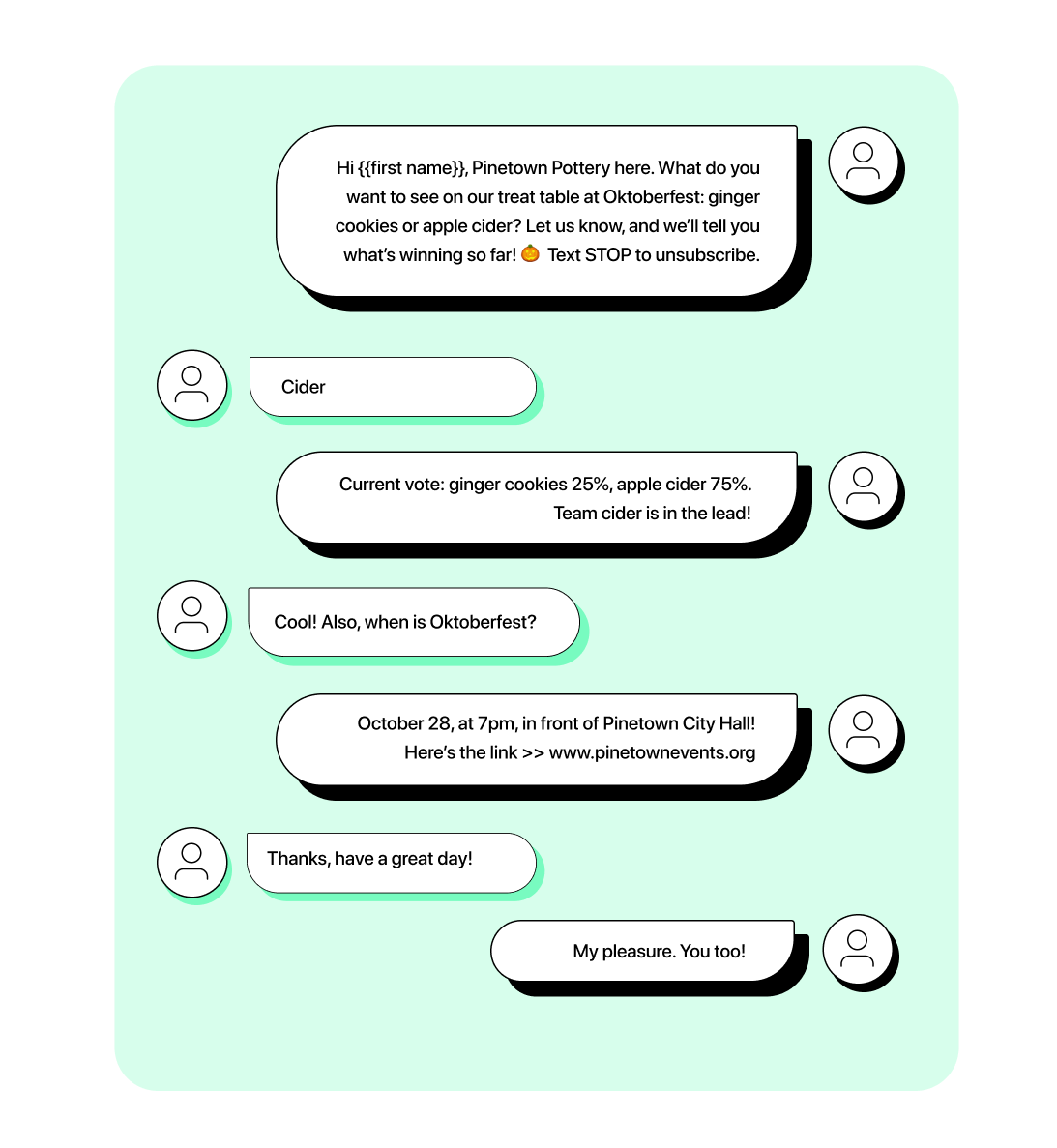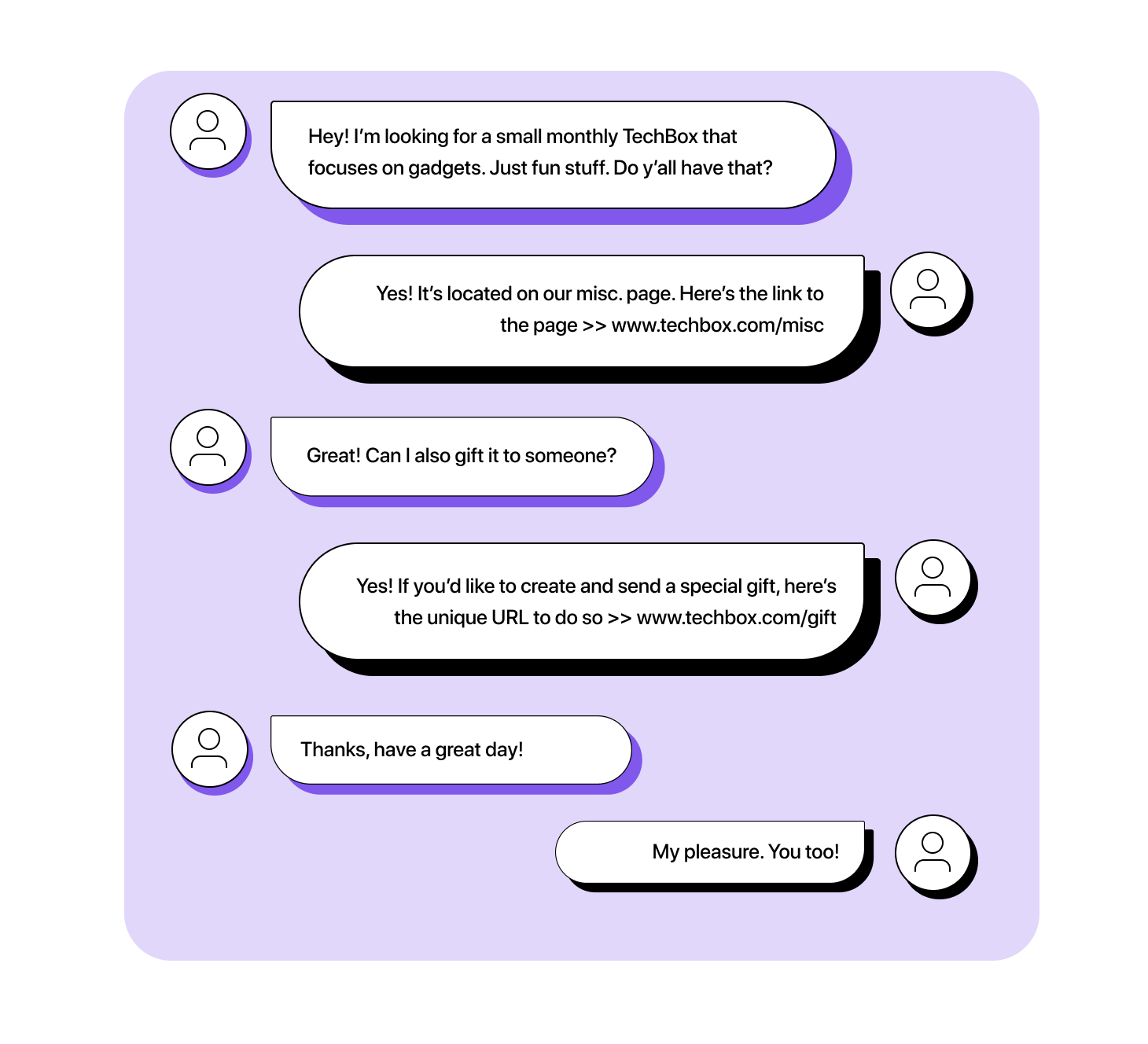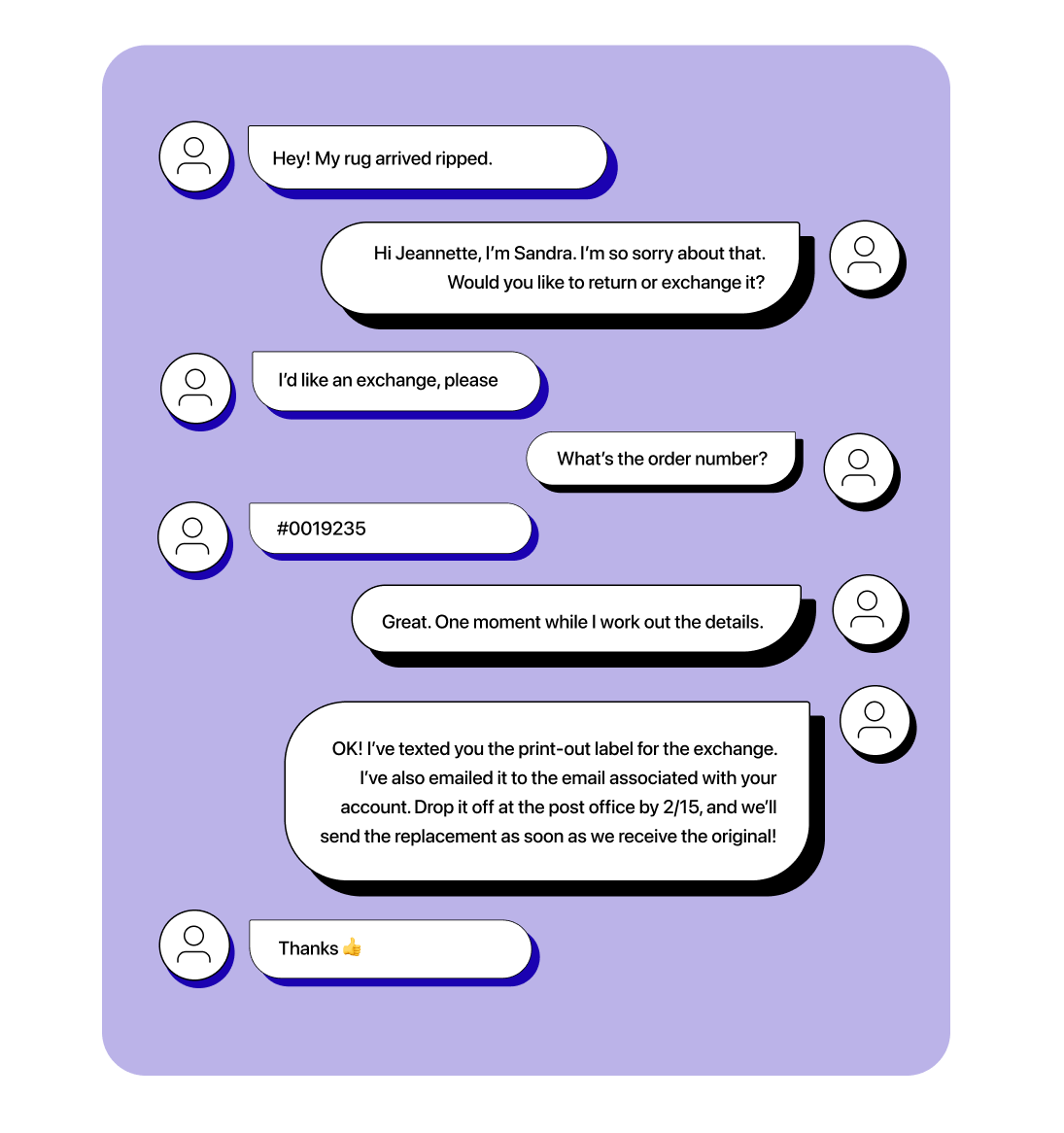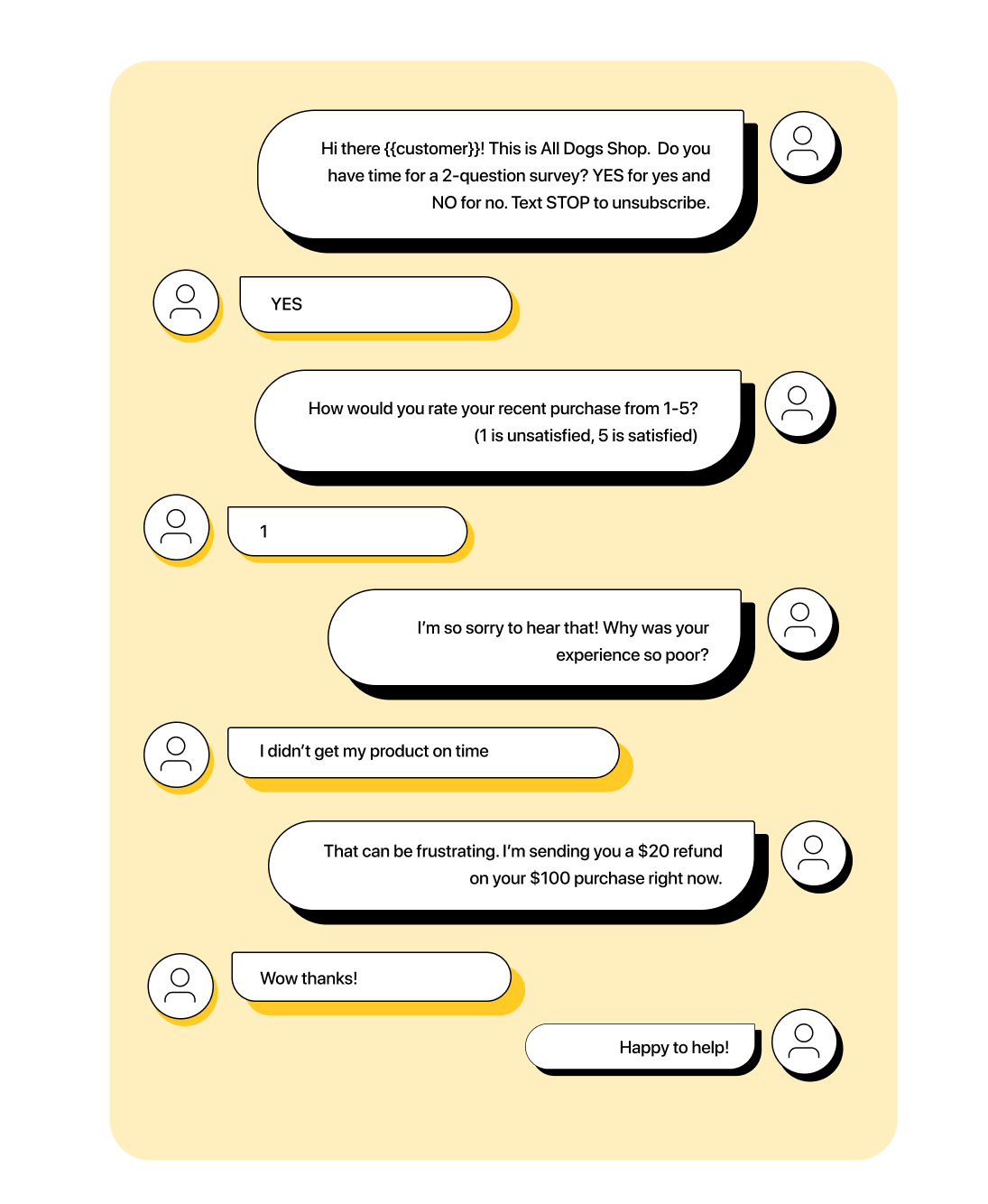
Conversational commerce has taken off in the past few years. Researchers predict that it will have a $290 billion spend by 2025—a 590% rise from 2021-2025. It’s no coincidence that messaging apps have popped up to support this growth, including Apple Messages for Business, Facebook Messenger, Google’s Business Messages, Instagram Messenger, Microsoft Teams, Telegram, Twist, Signal, Slack, and WhatsApp. Companies know that the demand for conversational channels is increasing.
But what does conversational commerce mean, and why do customers like it so much? In this guide, we’ll explore:
- What conversational commerce is
- Why leads and customers love it
- How it benefits your business
- What it looks like in action
Let’s dive deeper into conversational commerce, what it means, and why it’s critical to not only understand it, but to integrate it into your customer service process.
What Is Conversational Commerce?
Ninety percent of global internet users access chat apps on a regular basis. They rely on messaging to chat with not only friends and family, but also with coworkers. It’s a quick and easy way to stay connected with the important people in their lives while they’re on the go.
Customers want to message businesses, too. Eighty-five percent of smartphone users prefer mobile messaging to emails and calls when connecting with companies. They want to message in to discover products, ask questions, manage returns, and even make purchases. Shopping through real-time, technology-supported conversations is called conversational commerce.
Conversational commerce is conducted through channels that allow customers to connect with businesses in real time, like messaging apps (e.g., live chat, native SMS, Facebook Messenger) and voice technology (e.g., Alexa). These channels provide the speed and convenience customers expect while allowing them to make personal connections with live agents.
This term has been used frequently across industries in recent years, but it was invented by product designer Chris Messina, of Uber and Google. He wrote it on his personal blog in 2015.
Why Customers Love It
Conversational commerce has taken off in the past few years. Customers love how easy it is to discover and shop for products through a single channel. One-on-one chats also add a personal touch similar to what they’d experience in stores.
Simplified Shopping
Today’s customers want businesses to make shopping easy for them. Conversational commerce does exactly that.
Customers can gather information and make purchases on a single messaging channel. This saves them time that they would have spent flipping between a business’s product pages, checkout page, and customer service channels.
They also know they can return to that channel if they have any future problems with the product. Then, they can pick up right where they left off, especially if they’re working with a business that offers a seamless omnichannel experience.
Personal Touch
Even though today’s consumers are turning to online channels, 85% of them still crave human interactions while they shop.
Conversational commerce mimics the in-person sales associate experience. In a brick-and-mortar store, a customer might ask an associate a question, then, once they’ve gotten the information they need, follow the associate to a check-out counter.
With conversational commerce, customers are doing the same thing in the digital space. They get information from an online agent, then, if they’re interested, are shown a quick way to check out through a URL.
Conversational Benefits for Businesses
Conversational commerce provides customers with a simple, personalized path to online purchases. This kind of frictionless experience helps your customers and your business. Using it empowers you to:
Keep Customers Engaged
When you empower customers to conduct all or most of their shopping on a single channel, you make the process a lot more convenient. Reducing friction helps customers stay focused on the task at hand—researching and purchasing your product.
If customers can conduct all of their shopping activities in one place, they are less likely to:
- Become distracted
- Lose interest
- Stop the purchasing process
Ultimately, conversational commerce reduces the chances that customers will lose interest and stop the process of shopping with your brand.
Create Lasting Relationships
One of the key aspects of this strategy is one-on-one chats between customers and agents. After all, online customers want to make connections with other people. These chats increase customer satisfaction in the short term and increase the strength of relationships over time.
When customers make connections with agents, they aren’t likely to forget them. They’ll remember that talking to an agent was easy and enjoyable. When or if they run into questions about or challenges with your products or services, they’ll feel comfortable reaching out.
A continuous rapport with customers is key to strengthening your relationship over time.
Boost Revenue
Reducing friction and forming strong agent-to-customer relationships during the shopping experience shortens and smoothes the path to purchase. In other words, conversational commerce increases the chance that leads and customers will make purchases.
Big-name brands have been seeing the financial benefits of this strategy for years. For example, L’Oréal used conversational commerce to gain a month’s worth of sales in a mere twenty-four hours.
While boosting revenue isn’t the most important aspect of starting a new customer-facing strategy, it’s an unignorable bonus.
Conversational Commerce Examples
Now, you might be wondering what exactly conversational commerce looks like in action. Here are five examples of conversational messaging you might see with customers.
Conversational Marketing

Once customers opt into channels like native SMS and WhatsApp, you can send them conversational marketing content. First and foremost, this content encourages leads and customers to ask questions and engage with your team:
Agent: Hello Tina, Pinetown Pottery here. What do you want to see on our treat table at Oktoberfest: ginger cookies or apple cider? Let us know, and we’ll tell you what’s winning so far! 🎃 Text STOP to unsubscribe.
Lead: Cider!
Agent: Current vote: ginger cookies 25%, apple cider 75%. Team cider is in the lead!
Lead: Cool! Also, when is Oktoberfest?
Agent: October 28, at 7pm, in front of Pinetown City Hall! Here’s the link >> www.pinetownevents.org
Lead: Thanks, have a great day!
Agent: My pleasure. You too!
Conversational Sales

Once leads or customers are familiar with your products, they may start seeking out answers to more specific questions. If the lead or customer seems primed to make a purchase, agents can use conversational sales to direct them to make a purchase right through the messaging conversation. (Make sure your system works with a secure tool like Apple Pay or Google Pay.)
Lead: Hey! I’m looking for a small monthly TechBox that focuses on gadgets. Just fun stuff. Do y’all have that?
Agent: Yes! It’s located on our misc. page. Here’s the link to the page >> www.techbox.com/misc
Lead: Great! Can I also gift it to someone?
Agent: Yes! If you’d like to create and send a special gift, here’s the unique URL to do so >> www.techbox.com/gift
Lead: Thanks, have a great day!
Agent: My pleasure. You too!
Lead: Hi! I have a question about your new perfume.
Agent: Hi there! What would you like to know? —Bruno, Orchid Perfumes, Sales
Lead: Does it come in multiple sizes?
Agent: Yes! We have a 5 oz and a 12 oz size.
Lead: How much does an average person need?
Agent: If you only wear perfume on maybe once a week, I’d go with 5 oz. Any more than that, and you should try 12 oz.
Lead: Thank you!
Agent: Can I help you with anything else?
Lead: All good!
Conversational Support

Leads and customers may need help with their orders after the initial purchase. Here are two examples of service-focused conversational support chats, one featuring a lead and one featuring a customer:
Lead: Hey, I haven’t received a confirmation for my order yet.
Agent: Hi there, I’m Tan, and I’m here to help! What email account did you place the order through?
Lead: kendra15334@gmail.com
Agent: I’ve found your order! One moment while I resend your confirmation. Let me know when you receive it.
Lead: Got it!
Agent: Great! Can I do anything else for you today?
Lead: That’s all, bye!
Customer: Hey, my rug arrived ripped
Agent: Hi Jeannette, I’m Sandra. I’m so sorry about that. Would you like to return or exchange it?
Customer: I’d like an exchange, please
Agent: What’s the order number?
Customer: #0019235
Agent: Great. One moment while I work out the details.
Agent: Okay! I’ve texted you the print-out label for the exchange. I’ve also emailed it to the email associated with your account. Drop it off at the post office by 2/15, and we’ll send the replacement as soon as we receive the original!
Customer: Thanks 👍
Conversational Engagement

After customers make their purchases, it’s important to stay in touch. Reaching out regularly to make sure customers are satisfied keeps your rapport going strong—and encourages more purchases in the future. Some conversational messaging channels will offer you an automated chat-based survey, which allows you to set up the questions and send surveys. It will alert a team member if customers send low ratings (or questions) and need one-on-one support:
Agent: Hi there {{customer}}! This is All Dogs Shop. Do you have time for a 2-question survey? YES for yes and NO for no. Text STOP to unsubscribe.
Customer: YES
Agent: How would you rate your recent purchase with Home Furniture, LTD. from 1-5? (1 is unsatisfied, 5 is satisfied)
Lead: 1
Agent: I’m so sorry to hear that! Why was your experience so poor?
Lead: I didn’t get my product on time
Agent: That can be frustrating. I’m sending you a $20 refund on your $100 purchase right now.
Lead: Wow thanks!
Agent: Happy to help!
A New Future with Conversational Commerce
As consumers move more and more toward digital shopping, conversational commerce can help businesses keep up with them. The strategy meets customers where they are—on their phones and messaging apps—to streamline and personalize their experiences.
To start using conversational commerce, you have to adopt a conversational messaging channel. The platform should be able to accept and send messages from as many messaging channels as possible. The more entry points you offer, the more likely leads and customers will reach out and start their conversational journey.
Your platform should work with:
- Native SMS
- Web chats
- Messaging services (Facebook Messenger, Instagram Messaging, WhatsApp, Google’s Business Messages, Apple Messages for Business)
With help from these convenient channels, your business can focus on forming strong ongoing relationships with your customers—instead of using chats as a way to make quick sales.
Interested in conversational commerce? Find more information in our blog.




